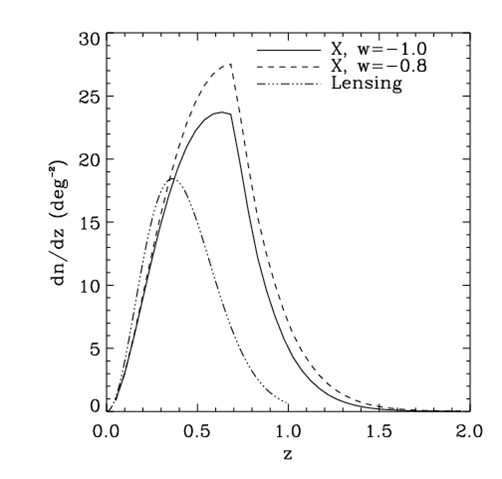 |
 |
|---|
Index - Consortium - The survey characteristics - Scientific Goals - ...
 |
 |
|---|
2.1 - The survey sensitivity
We perform a 8 x 8 deg2 survey at high galactic latitude to
reach a sensitivity of ~ 5 10-15 erg.cm-2.s-1 in the [0.5-2] keV band.
The survey consist of 24 x 24 10 ks XMM/EPIC pointings separated by
20 arcmin offsets.
Current pointings.
2.2 - The survey location ** Modified Location Oct 2003; new center: 2h 18m 00s, -7° 00' 00" (J2000)**
 |
New center (J2000):
2h 18m 00s -7° 00' 00" |
|
XMDS & VVDS deep
VVDS wide XMM Subaru Deep Survey SIRTF Legacy : SWIRE NOAO Deep Survey Galex |
|
|
nh_2.pdf (37144 bytes) |
2.3 - The expected numbers of objects
2.3.1 - Clusters of galaxies

Current favoured values have been assumed here for
 CDM. For this model, the entire
cluster/group population will be detected out to z = 0.5 and the
total number of clusters will be of the order of 900 between
0 < z < 1. The XMM-LSS will also be ideal to probe the
behaviour of the bright end of the XLF beyond z > 1 : a new
exciting territory.
CDM. For this model, the entire
cluster/group population will be detected out to z = 0.5 and the
total number of clusters will be of the order of 900 between
0 < z < 1. The XMM-LSS will also be ideal to probe the
behaviour of the bright end of the XLF beyond z > 1 : a new
exciting territory.
Note: these numbers are quite sensitive to the adopted values for the cosmological parameters as well as to the the uncertainties in the M-L-T relationships at high redshifts. By the time the XMM-LSS is completed, better insights will be gained thanks to deep pointed cluster observations. Indeed, physical processes, such as feedback from early star formation and reionization, can modify these relationships and therefore yield detectable changes in the cluster counts and correlation function . Another important issue is the existence of high redshift cooling flows which may affect the detectability of distant clusters and their L-T relationship.
There will be about 50 clusters with useful X-ray spectroscopic information over the entire area (1000 photons collected within R1 in the [0.4-4] keV band). They will be located below z < 0.5.
2.3.2 - AGN and QSO... and stars
For a 10 ks XMM exposure, it will be possible to detect with the PN + MOS
instruments (5  detections) point-like
sources brighter than typically
3 10-15 erg.cm-2.s-1 in the
[0.5-2] keV band. At such low flux, we expect to detect approximately
300 X-ray sources per square degree, among which typically
(cf. Lehmann et al. 2001): 15-20 will be clusters of galaxies, about
200 AGNs and QSOs and the remainder stars and nearby galaxies.
detections) point-like
sources brighter than typically
3 10-15 erg.cm-2.s-1 in the
[0.5-2] keV band. At such low flux, we expect to detect approximately
300 X-ray sources per square degree, among which typically
(cf. Lehmann et al. 2001): 15-20 will be clusters of galaxies, about
200 AGNs and QSOs and the remainder stars and nearby galaxies.
Thus, in total, 100 QSO/AGN per deg2 with z < 1. The surface density of QSOs/AGN (~ 200 objects per square degree) in the proposed XMM-LSS survey is almost an order of magnitude larger than those expected in the forthcoming (color biased, z < 2.5, ...) optical surveys carried out over large sky areas (SDSS, 2dF, etc.). Furthermore, compared to optical surveys, the completeness of X-ray selected QSOs/AGN is known to be much better defined.